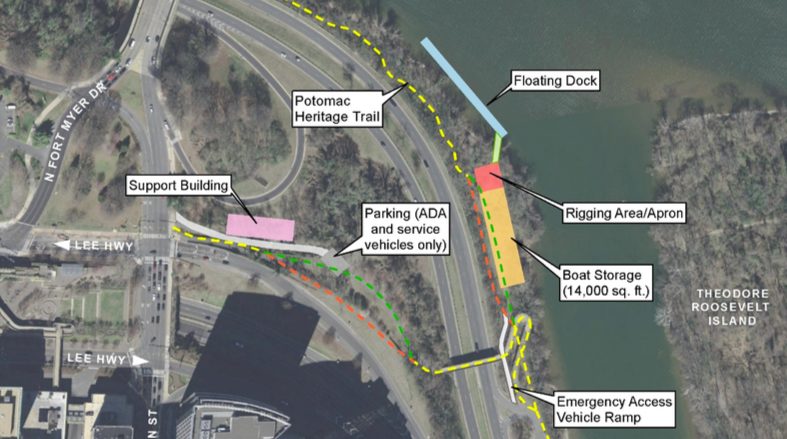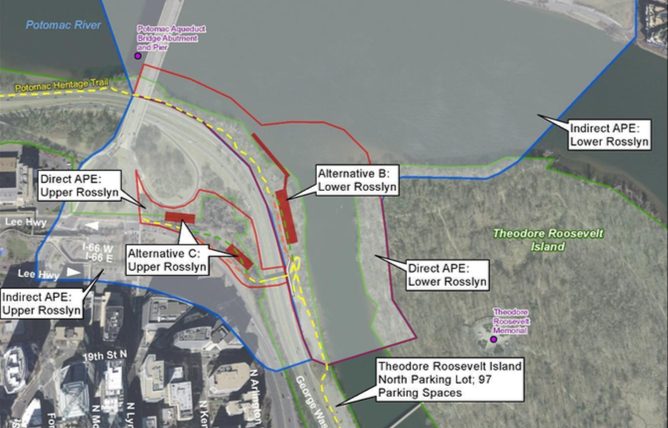Arlington County Board is scheduled to vote on the latest step in the decades-long plan to build a Rosslyn boathouse.
On Saturday, members are set to consider a “programmatic agreement” to build a boathouse at 1101 Lee Highway in Rosslyn, which would allow non-motorized boats like kayaks to launch into the Potomac from Arlington’s shore.
The county purchased land south of the Key Bridge in 2014 to help hasten the permitting process with the National Park Service, which is overseeing the project.
County spokeswoman Jennifer Smith said this agreement, if approved, would bring the country one paddle closer to a boathouse:
The Programmatic Agreement is a routine element of the environmental review process and reflects the intent of National Park Service and the various regional parties involved in development of the project to cooperate in implementing it. The Board vote is required to authorize the County Manager to sign the agreement. This administrative step, if approved by the Board and by other regional entities, would allow for the National Park Service’s Environmental Assessment to be completed. Completing the EA is an important next step in the project’s timeline. A public process for development of the boathouse would be established separately.
A copy of the design plans shared in a staff report to the Board call for:
- a 14,000-square-foot boat storage house that’s designed to be flood-resistant
- a 300-foot-long dock for non motorized boats (like kayaks)
- a building for bathrooms, locker rooms, educational rooms, and offices
- an ADA-compliant parking area
- a 300-foot-long emergency vehicle access lane
“The Arlington County and Vicinity Boathouse project is included in the Adopted Fiscal Years (FY) 2019-2028 Capital Improvement Plan (CIP), which envisions $500,000 in FY 2022 for development of the management model and formulation of the long-term use arrangement and $2.245 million in FY 2026 for the final design of the Boathouse project,” the staff report says.
It’s been almost 25 years since the “boathouse task force” formed to propose the idea, but the project didn’t gain momentum until 2012 when the National Park Service began studying potential environmental impacts. The study was put on hold several times, before resuming in 2016.
At the time, the Park Service worried about how construction could affect flood plains along the river, as well as species that called the waterway home.
In this week’s staff report, a resolution says that the Park Service determined that the boathouse could “have a direct adverse effect on the George Washington Memorial Parkway Historic District and an indirect adverse effect on Theodore Roosevelt Island.” However, it approved going forward provided the following steps were taken to reduce impact:
- Restricting and minimizing ground and vegetation disturbance during construction, including limiting tree removal.
- Minimizing the size of construction equipment and using minimally invasive construction methods.
- Developing a “light on the land” facility with a minimal footprint and massing that is in scale with the surrounding landscape.
- Limiting the depth of excavation to avoid disturbing any unknown archeological resources below the depth of previous testing.
- Keeping a 50-100 foot area of protection around known archeological sites where heavy equipment is not allowed to help avoid compression/compaction.
- Applying avoidance and minimization strategies to staging and storage areas as well.
The project has many fans in the county’s rowing community, which recently banded together to reinforce their support for the water sport after APS threatened to cut the high school teams from the county’s budget.
The Arlington Boathouse Foundation writes on its website that although the county was among the first to introduce rowing teams to its high schools, teams for many years have had to launch crew boats out of D.C. “The George Washington Memorial Parkway severed Arlington’s access to its own shoreline,” the foundation notes.
Since the D.C. boathouse serves multiple jurisdictions, accessing those facilities can be tricky.
“Some area boathouses have a two- to three-year waiting list for membership and an additional waiting list for storage space for a single scull,” the National Park Service wrote on its website about the Rosslyn plan.



